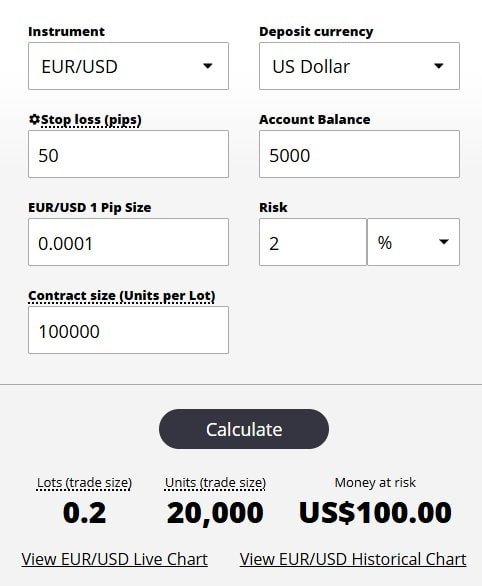The 2% Rule: Managing Risk in Forex Trading
Introduction
Risk management is crucial in forex trading. The 2% rule is a popular method to limit losses and preserve trading capital. This guide explores the rule’s benefits and provides practical steps to apply it effectively.
🔍 What Is the 2% Rule?
The 2% rule means risking no more than 2% of your total account balance on a single trade. This ensures that losing streaks don’t quickly wipe out your account.
Example Calculation:
- If your account balance is $10,000, the maximum risk per trade would be $200 (2%).
- For a trade requiring a 50-pip stop-loss, adjust your lot size so the total risk equals $200.
Here’s your clear, easy-to-follow table illustrating a $50,000 trading account with a 2% risk per trade, including position sizing examples for Gold, Crude Oil, Natural Gas, S&P 500, Nasdaq, EUR/USD, and Bitcoin.
Assumptions:
- All trades risk 2% of a $50,000 account (=$1,000 per trade).
- Lot sizes calculated based on typical contract specifications and standard pip/tick values.
| Asset | Account Size ($) | Risk (%) | Risk Amount ($) | Stop Loss | Lot Size |
|---|---|---|---|---|---|
| Gold (XAU/USD) | 50,000 | 2% | 1,000 | 50 pips | 2 lots |
| Crude Oil (WTI) | 50,000 | 2% | 1,000 | 100 ticks | 1 lot |
| Natural Gas (NG) | 50,000 | 2% | 1,000 | 200 ticks | 0.5 lots |
| S&P 500 (ES) | 50,000 | 2% | 1,000 | 20 points | 1 contract |
| Nasdaq (NQ) | 50,000 | 2% | 1,000 | 40 points | 0.5 contracts |
| EUR/USD (Forex) | 50,000 | 2% | 1,000 | 50 pips | 2 standard lots |
| Bitcoin (BTC/USD) | 50,000 | 2% | 1,000 | 500 points | 0.02 lots (approx.) |
Explanations & Calculations (briefly explained):
- Gold (XAU/USD):
Standard lot pip value: ~$10/pip
Calculation: $1,000 ÷ 50 pips ÷ $10 per pip = 2 lots - Crude Oil (WTI):
Standard contract tick value: $10/tick
Calculation: $1,000 ÷ 100 ticks ÷ $10 per tick = 1 lot - Natural Gas (NG):
Standard contract tick value: $10/tick
Calculation: $1,000 ÷ 200 ticks ÷ $10 per tick = 0.5 lots - S&P 500 (ES):
Standard E-mini S&P tick value: $12.50 per tick (4 ticks = 1 point, thus $50 per point)
Calculation: $1,000 ÷ 20 points ÷ $50 per point = 1 contract - Nasdaq (NQ):
Standard E-mini Nasdaq tick value: $5 per tick (4 ticks = 1 point, thus $20 per point)
Calculation: $1,000 ÷ 40 points ÷ $20 per point = 1.25 ≈ rounded to 1 or 0.5 contracts for conservative sizing - EUR/USD (Forex):
Standard lot pip value: $10/pip
Calculation: $1,000 ÷ 50 pips ÷ $10 per pip = 2 lots - Bitcoin (BTC/USD):
Typical lot size 1 BTC = $1 per point
Calculation: $1,000 ÷ 500 points ÷ $1 per point = 0.02 BTC
This provides a clear framework for setting lot sizes and risk management across diverse markets.
Here’s a clear breakdown of pips, points, and ticks, highlighting their differences and their typical use across various financial markets:
📌 Pip (Percentage in Point)
A pip is the smallest standardized price increment used primarily in forex markets. It typically represents the fourth decimal place in most currency pairs, except for pairs involving JPY, where a pip represents the second decimal place.
- Examples:
- EUR/USD from 1.1050 → 1.1051 (change = 1 pip)
- USD/JPY from 110.20 → 110.21 (change = 1 pip)
Common Use: Forex (Currency Pairs)
📌 Point
A point refers to the smallest unit of price change on the left side of a decimal. It represents the most basic unit of price movement in many indices, stocks, commodities, or cryptocurrencies. It’s not standardized across markets, as each market sets its own scale.
- Examples:
- S&P 500 moves from 4,000 → 4,001 (change = 1 point)
- Gold (XAU/USD) moves from 2000.00 → 2001.00 (change = 1 point)
Common Use: Stock indices (e.g., Dow, S&P 500, NASDAQ), Commodities (Gold), Cryptocurrencies (Bitcoin)
📌 Tick
A tick represents the smallest possible increment or decrement at which the price of a particular market or instrument can trade. It varies significantly by market and instrument.
- Examples:
- Crude Oil (WTI) typically moves in increments of $0.01 per barrel (1 tick = $0.01).
- E-mini S&P 500 futures trade in 0.25 point increments (each increment = 1 tick).
- If S&P 500 futures move from 4000.00 → 4000.25, that’s 1 tick (but 0.25 points).
Common Use: Futures markets, Commodity markets
✅ Quick Summary Table
| Term | Markets | Represents | Example |
|---|---|---|---|
| Pip | Forex | Smallest increment in currency prices | EUR/USD 1.1050 → 1.1051 |
| Point | Stocks, Indices, Crypto, Commodities | Basic unit of price movement | Gold (XAU) $2000 → $2001, S&P 500: 4000 → 4001 |
| Tick | Futures, Commodities | Minimum increment instrument trades | E-mini S&P moves 4000.00 → 4000.25 |
🎯 Why These Differences Matter:
- Risk Management:
Precise position sizing depends on accurately calculating risk per pip, point, or tick. - Trading Costs:
Spreads or commissions often quoted in terms of these increments, so knowing their value helps manage costs. - Order Accuracy:
Correctly placing stop-loss and take-profit orders requires understanding the minimum increments for the specific market traded.
🚨 Why the 2% Rule Works
1. Prevents Large Drawdowns
- Reduces impact from multiple consecutive losing trades.
2. Encourages Consistency
- Keeps trading disciplined and prevents emotional decision-making.
3. Protects Trading Psychology
- Reduces emotional stress from large losses.
- Promotes long-term profitability rather than chasing quick wins.
📉 Image Suggestion: A graph comparing account equity curves with and without using the 2% rule.
📌 How to Apply the 2% Rule in Your Trading
Step 1: Determine Your Account Balance
- Example: $5,000 trading account
- 2% risk per trade: $100 maximum per trade
Step 2: Calculate Position Size
- Define your stop-loss distance (in pips).
- Use the formula:
- Position Size = (Risk per Trade) / (Pip Value × Stop-Loss in Pips)
Example:
- Risk = $100
- Stop-loss = 50 pips
- Pip Value = $1 per pip (for 1 mini lot)
Position Size: 100 ÷ (50 × 1) = 2 mini lots
✅ Check your calculations!
Risk Calculator

❌ Common Mistakes to Avoid
- Ignoring Risk-Reward Ratios: Always aim for at least a 1:2 ratio.
- Overleveraging: Even with the 2% rule, excessive leverage can amplify losses.
- Adjusting Risk per Trade: Consistency is key—avoid altering your risk based on emotions.
🎯 Conclusion
The 2% rule is a powerful tool in managing trading risk. Incorporate it into your trading strategy to enhance discipline, protect your capital, and achieve consistent results.
🚀 Next Steps:
✅ Learn more about Position Sizing Strategies Introduction

